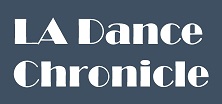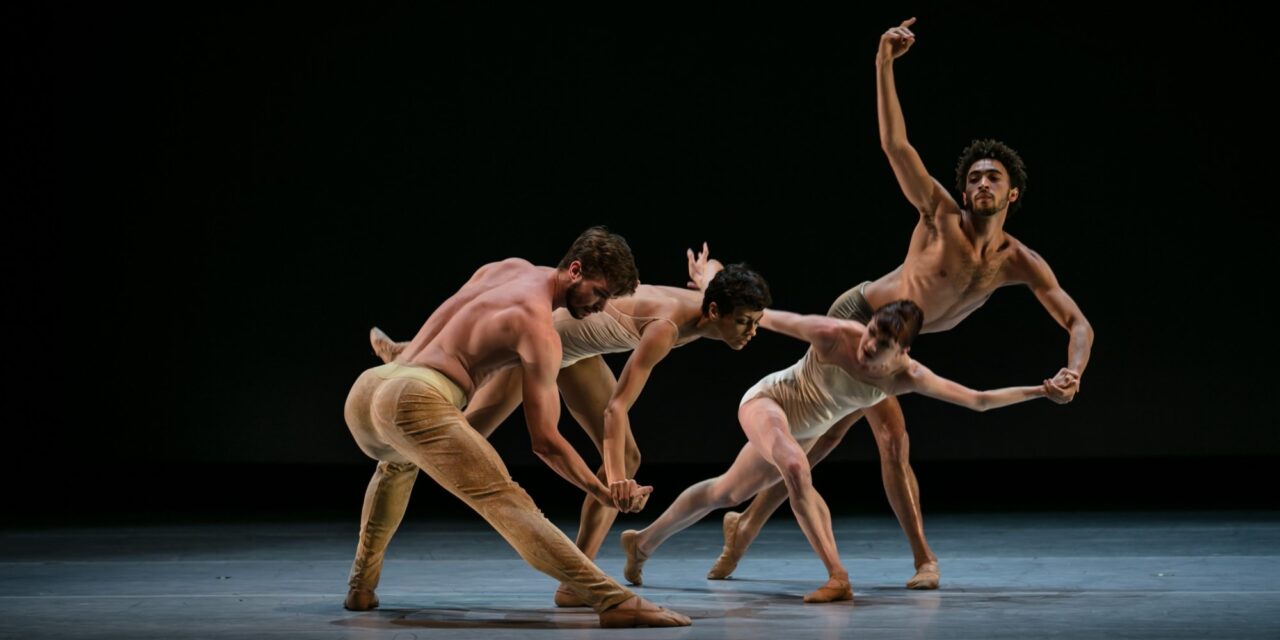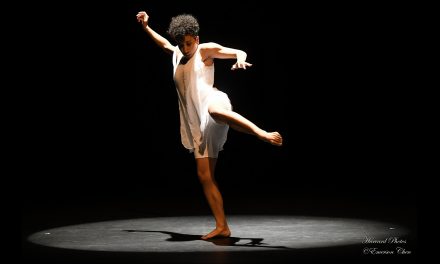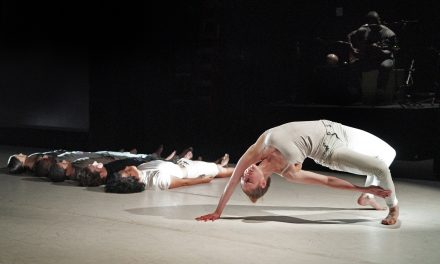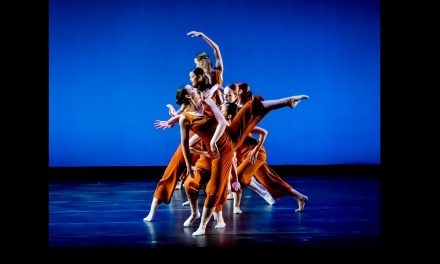This Alonzo Kine LINES Ballet program at the Segerstrom Center of the Arts consisted of two works both premiered in San Francisco in 2024, and both choreographed by King. The first was “Ma Mére L’oye (Mother Goose)” or technically, “My Mother the Goose” with music by Maurice Ravel. The work followed the order of the original ballet created by Ravel with the familiar storybook characters of Sleeping Beauty, Beauty and the Beast, and Tom Thumb to name a few. Ravel originally created the piece for two pianos in 1910. In 1911, he orchestrated the five-piece suite and later the same year expanded it into a ballet, separating the five initial pieces with four new interludes and adding two movements at the start, Prélude and Danse du rouet et scène. The ballet premiered on 29 January 1912 at the Théâtre des Arts in Paris. King has kept the original order of the dances without the interludes. I was lost as to the identities of the storybook characters and what they were doing onstage other than pure movement. The choreography was specific and engaging and obviously had a purpose. The steps were intricate and difficult in terms of technique and much of it was off-balance or cantilevered giving a dangerous effect.
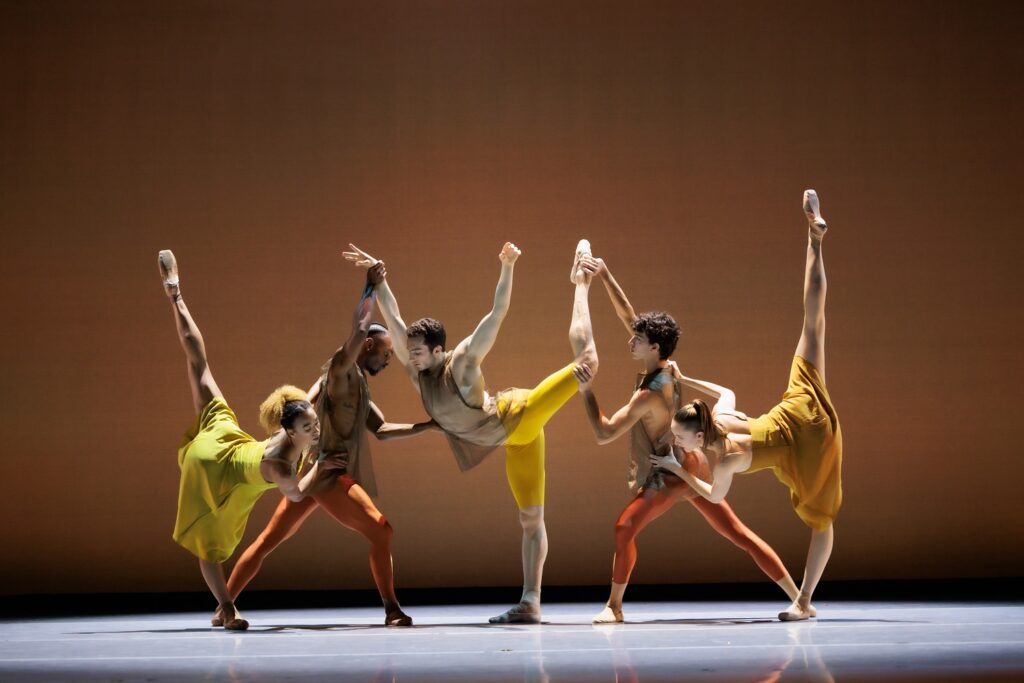
Alonzo King LINES Ballet – Marusya Madubuko, Joshua Francique, Theo-Duff, Grant-Mael, Amatoul-Tatum, Quinonezonez in “Mother Goose” – Photo ©Chris Hardy.
This was a comprehensive piece in that it showcased each dancer beautifully while following Kings’ interest in “the manipulation of energies that exist in matter through laws which govern the shapes and movement directions of everything that exists” (program note). By this I’m assuming we are talking about Sir Isaac Newton’s Laws of Motion. First Law=inertia, Second Law=force, Third Law=action and reaction. And let us not forget gravity acting upon the whole. Newton laid all of this out in his “Principia Mathematica Philosophiae Naturalis.” It means we have been getting hit in the head by apples ever since. And through Alonso King’s manipulations it means a somewhat startling and surprising movement vocabulary with off-balanced twists and turns, switches from parallel to turned-out, and the spine rolling through to haul the rest of the body up in its’ wake. None of which is unpleasant. He calls his works “thought structures” and that is what they are in that they require the onlooker to observe and then be pulled into the physics of what they are based on. Why would someone move like that? How did they move like that? Even in the partnering and to a certain degree especially in the partnering we see cantilevered promenades with the female off center of her pointe. Interesting and ultimately fascinating. Mathematics as movement. I may be off here but this is what I got out of it.
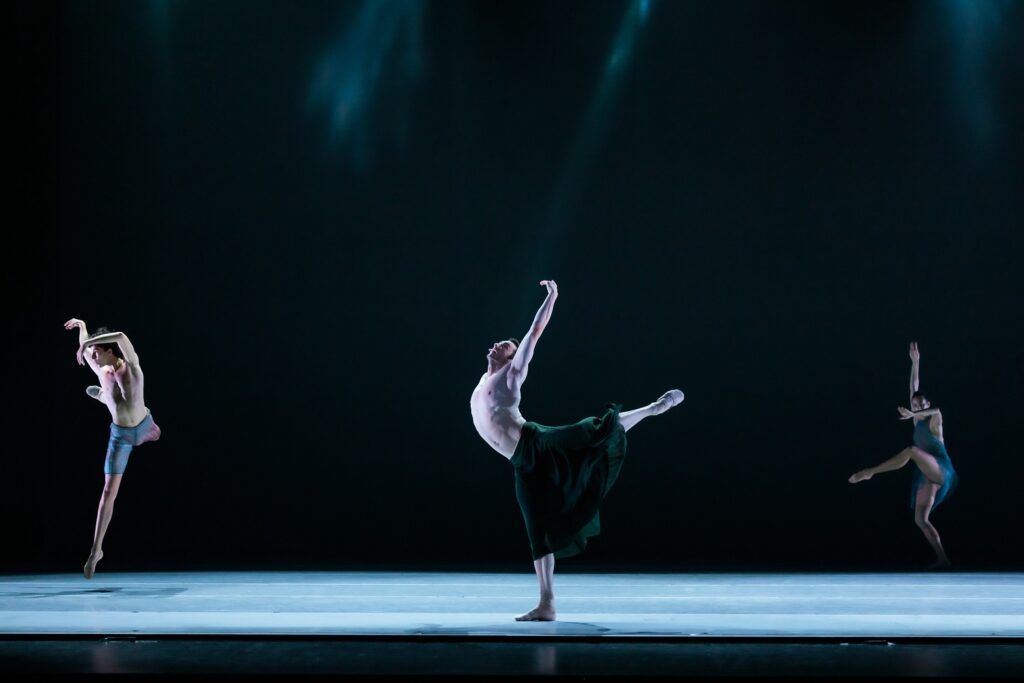
Alonzo King LINES Ballet – Theo Duff Grant with Mael Amatoul and Amanda Smith in “Ode to Alice Coltrane” – Photo ©Chris Hardy.
The second work was “Ode to Alice Coltrane” which was set to different compositions of her music. Coltrane was an American jazz musician, composer, bandleader and Hindu spiritual leader among many other talents. According to the program notes, King set his very first piece of choreography to the music of Alice Coltrane in 1982 at the McKenna Theater at San Francisco State University. He had been “mesmerized” by her music since a child. And it shows. The great care and detail of the work is breathtaking. The lighting design by Seah Johnson complimented the dancers’ movements in brilliant fashion. It was reminiscent of the Northern Lights playing across the backdrop. This coruscating curtain of colored light offset the figures onstage and made them pop out more. Interestingly the lava lamp effect didn’t take our attention away from the dancers onstage but drew focus to them. At times, the light was eerie but effective. The costumes by Robert Rosenwasser showed lots of skin with the men shirtless and wearing long skirts or short tights to the knee, while the women had short shimmering dresses that moved well with the body. The choreography featured the human body as sculptural art. Torsos undulating, sweat glistening reminiscent of the Doryphoros by Polykleitos or Apoxyomenos of Lysippus. The music was matched by the intensity of the physics portrayed. The dancers rewarded with a deserved standing ovation at the end. They were: Mael Amatoul, Babatunji, Adji Cissoko, Theo Duff-Grant, Lorris Eichinger, Shuaib Elhassan, Joshua Fransique, Mikal Gilbert, Ilaria Guerra, Marusya Madubuko, Tatum Quinonez, and Amanda Smith.
For more information about Alonzo King LINES Ballet, please visit their website.
To learn more about the Segerstrom Center for the Arts, please visit their website.
Written by Brian Fretté for LA Dance Chronicle.
Featured image: Alonzo King LINES Ballet in King’s “Concerto for Two Violins” – Photo courtesy of the company.
